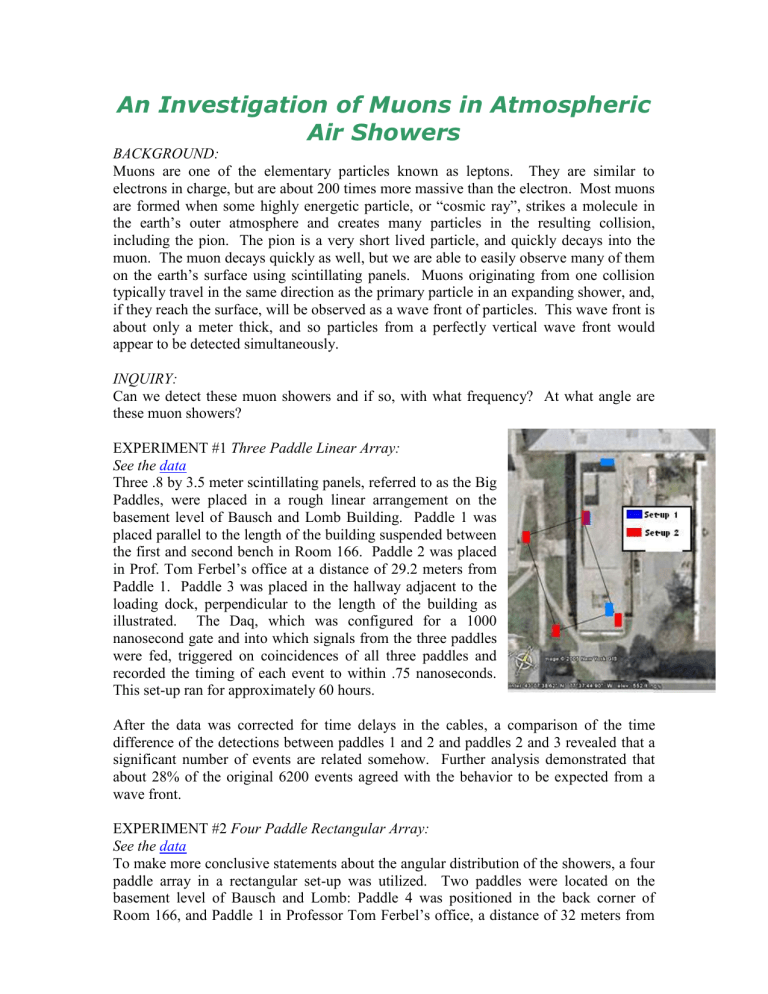An Investigation of Muons in Atmospheric Air Showers

An Investigation of Muons in Atmospheric
Air Showers
BACKGROUND:
Muons are one of the elementary particles known as leptons. They are similar to electrons in charge, but are about 200 times more massive than the electron. Most muons are formed when some highly energetic particle, or “cosmic ray”, strikes a molecule in the earth’s outer atmosphere and creates many particles in the resulting collision, including the pion. The pion is a very short lived particle, and quickly decays into the muon. The muon decays quickly as well, but we are able to easily observe many of them on the earth’s surface using scintillating panels. Muons originating from one collision typically travel in the same direction as the primary particle in an expanding shower, and, if they reach the surface, will be observed as a wave front of particles. This wave front is about only a meter thick, and so particles from a perfectly vertical wave front would appear to be detected simultaneously.
INQUIRY:
Can we detect these muon showers and if so, with what frequency? At what angle are these muon showers?
EXPERIMENT #1 Three Paddle Linear Array:
Three .8 by 3.5 meter scintillating panels, referred to as the Big
Paddles, were placed in a rough linear arrangement on the basement level of Bausch and Lomb Building. Paddle 1 was placed parallel to the length of the building suspended between the first and second bench in Room 166. Paddle 2 was placed in Prof. Tom Ferbel’s office at a distance of 29.2 meters from
Paddle 1. Paddle 3 was placed in the hallway adjacent to the loading dock, perpendicular to the length of the building as illustrated. The Daq, which was configured for a 1000 nanosecond gate and into which signals from the three paddles were fed, triggered on coincidences of all three paddles and recorded the timing of each event to within .75 nanoseconds.
This set-up ran for approximately 60 hours.
After the data was corrected for time delays in the cables, a comparison of the time difference of the detections between paddles 1 and 2 and paddles 2 and 3 revealed that a significant number of events are related somehow. Further analysis demonstrated that about 28% of the original 6200 events agreed with the behavior to be expected from a wave front.
EXPERIMENT #2 Four Paddle Rectangular Array:
To make more conclusive statements about the angular distribution of the showers, a four paddle array in a rectangular set-up was utilized. Two paddles were located on the basement level of Bausch and Lomb: Paddle 4 was positioned in the back corner of
Room 166, and Paddle 1 in Professor Tom Ferbel’s office, a distance of 32 meters from
Paddle 4. Paddles 2 and 3 were placed outside the building at a distance of 18.6 meters from the locations of Paddles 1 and 4, respectively. Data based on coincidences of any three paddles was collected for 2.5 hours, and later adjusted for the time delay due to the cables.
0.003
0.0025
0.002
It was possible to use the timing data determine the horizontal direction of the wave front,
Corrected Declination Angles and using some trigonometry and the assumed value of the speed of a muon, the declination angle was calculated and corrected for various factors, such as the greater
Four Muon Air
Show ers
Distribution for
Single Muons solid angle that can be observed closer to the horizon and the smaller area of the detector that is presented to the wave front. As can be anticipated by prior
0.0015
investigations into the behavior of single muons, the number of events
0.001
0.0005
found drops off as the angle from vertical increases. However, while the angular distribution for single
0
0 5 10 15 20 25 30 35 40 45 50 55 60 65 70 75 80 85 90 95
Degrees from Vertical muons follows a cosine squared trend, we find that four-muon shower events show a steeper rate of decrease as the angle from vertical increases than do individual muons. One factor that may play a part in explaining this difference is the greater distance of atmosphere the particles must travel through if they approach at a greater angle.
Three Dimensional Angular
Distribution of Wave Fronts
90
Another question that could be asked is if the muon showers come from any one direction more frequently than others. By calculating the projection of the angles into
80
70
60
50 two perpendicular vertical planes and plotting them, we can look to see if the cluster of points shift more in any one
40
30
20 direction or another, such as north. While it turns out there is no discernable shift, there is a wider spread of events in the X plane than the Y, which is probably a reflection of the rectangular versus square arrangement of the paddles. In conclusion, muon showers seem to come from within 45 degrees of vertical and do not come from any one direction more or less frequently than any other.
10
0
- 10
0
- 20
- 30
- 40
- 50
- 60
- 70
- 80
- 90
10 20 30 40 50 60 70 80 90
Angle of Projection onto the XZ Plane


